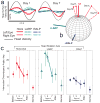Cross-axis adaptation improves 3D vestibulo-ocular reflex alignment during chronic stimulation via a head-mounted multichannel vestibular prosthesis
- PMID: 21374081
- PMCID: PMC3270066
- DOI: 10.1007/s00221-011-2591-5
Cross-axis adaptation improves 3D vestibulo-ocular reflex alignment during chronic stimulation via a head-mounted multichannel vestibular prosthesis
Abstract
By sensing three-dimensional (3D) head rotation and electrically stimulating the three ampullary branches of a vestibular nerve to encode head angular velocity, a multichannel vestibular prosthesis (MVP) can restore vestibular sensation to individuals disabled by loss of vestibular hair cell function. However, current spread to afferent fibers innervating non-targeted canals and otolith end organs can distort the vestibular nerve activation pattern, causing misalignment between the perceived and actual axis of head rotation. We hypothesized that over time, central neural mechanisms can adapt to correct this misalignment. To test this, we rendered five chinchillas vestibular deficient via bilateral gentamicin treatment and unilaterally implanted them with a head-mounted MVP. Comparison of 3D angular vestibulo-ocular reflex (aVOR) responses during 2 Hz, 50°/s peak horizontal sinusoidal head rotations in darkness on the first, third, and seventh days of continual MVP use revealed that eye responses about the intended axis remained stable (at about 70% of the normal gain) while misalignment improved significantly by the end of 1 week of prosthetic stimulation. A comparable time course of improvement was also observed for head rotations about the other two semicircular canal axes and at every stimulus frequency examined (0.2-5 Hz). In addition, the extent of disconjugacy between the two eyes progressively improved during the same time window. These results indicate that the central nervous system rapidly adapts to multichannel prosthetic vestibular stimulation to markedly improve 3D aVOR alignment within the first week after activation. Similar adaptive improvements are likely to occur in other species, including humans.
Figures






Similar articles
-
Restoration of 3D vestibular sensation in rhesus monkeys using a multichannel vestibular prosthesis.Hear Res. 2011 Nov;281(1-2):74-83. doi: 10.1016/j.heares.2011.08.008. Epub 2011 Aug 26. Hear Res. 2011. PMID: 21888961 Free PMC article.
-
Directional plasticity rapidly improves 3D vestibulo-ocular reflex alignment in monkeys using a multichannel vestibular prosthesis.J Assoc Res Otolaryngol. 2013 Dec;14(6):863-77. doi: 10.1007/s10162-013-0413-0. Epub 2013 Sep 8. J Assoc Res Otolaryngol. 2013. PMID: 24013822 Free PMC article.
-
A multichannel semicircular canal neural prosthesis using electrical stimulation to restore 3-d vestibular sensation.IEEE Trans Biomed Eng. 2007 Jun;54(6 Pt 1):1016-30. doi: 10.1109/TBME.2007.894629. IEEE Trans Biomed Eng. 2007. PMID: 17554821 Free PMC article.
-
Current and future management of bilateral loss of vestibular sensation - an update on the Johns Hopkins Multichannel Vestibular Prosthesis Project.Cochlear Implants Int. 2010 Sep;11 Suppl 2(Suppl 2):2-11. doi: 10.1179/146701010X12726366068454. Cochlear Implants Int. 2010. PMID: 21756683 Free PMC article. Review.
-
Progress toward development of a multichannel vestibular prosthesis for treatment of bilateral vestibular deficiency.Anat Rec (Hoboken). 2012 Nov;295(11):2010-29. doi: 10.1002/ar.22581. Epub 2012 Oct 8. Anat Rec (Hoboken). 2012. PMID: 23044664 Free PMC article. Review.
Cited by
-
Nonhuman primate vestibuloocular reflex responses to prosthetic vestibular stimulation are robust to pulse timing errors caused by temporal discretization.J Neurophysiol. 2019 Jun 1;121(6):2256-2266. doi: 10.1152/jn.00887.2018. Epub 2019 Apr 17. J Neurophysiol. 2019. PMID: 30995152 Free PMC article.
-
Restoration of 3D vestibular sensation in rhesus monkeys using a multichannel vestibular prosthesis.Hear Res. 2011 Nov;281(1-2):74-83. doi: 10.1016/j.heares.2011.08.008. Epub 2011 Aug 26. Hear Res. 2011. PMID: 21888961 Free PMC article.
-
Safe direct current stimulation to expand capabilities of neural prostheses.IEEE Trans Neural Syst Rehabil Eng. 2013 Mar;21(2):319-28. doi: 10.1109/TNSRE.2013.2245423. IEEE Trans Neural Syst Rehabil Eng. 2013. PMID: 23476007 Free PMC article.
-
Vestibular-related eye movements in the rat following selective electrical stimulation of the vestibular sensors.J Comp Physiol A Neuroethol Sens Neural Behav Physiol. 2018 Oct;204(9-10):835-847. doi: 10.1007/s00359-018-1286-9. Epub 2018 Sep 11. J Comp Physiol A Neuroethol Sens Neural Behav Physiol. 2018. PMID: 30206680
-
Virtual Rhesus Labyrinth Model Predicts Responses to Electrical Stimulation Delivered by a Vestibular Prosthesis.J Assoc Res Otolaryngol. 2019 Aug;20(4):313-339. doi: 10.1007/s10162-019-00725-3. Epub 2019 Jun 4. J Assoc Res Otolaryngol. 2019. PMID: 31165284 Free PMC article.
References
-
- Angelaki DE, Hess BJ. Visually induced adaptation in three-dimensional organization of primate vestibuloocular reflex. J Neurophysiol. 1998;79(2):791–807. - PubMed
-
- Aw ST, Halmagyi GM, Haslwanter T, Curthoys IS, Yavor RA, Todd MJ. Three-dimensional vector analysis of the human vestibuloocular reflex in responseto high-acceleration head rotations. II. responses in subjects with unilateral vestibular loss and selective semicircular canal occlusion. J Neurophysiol. 1996;76(6):4021–30. - PubMed
-
- Baird RA, Desmadryl G, Fernandez C, Goldberg JM. The vestibular nerve of the chinchilla 2. Relation between afferent response properties and peripheral innervation patterns in the semicircular canals. J Neurophysiol. 1988;60:182–203. - PubMed
-
- Baker JF, Wickland C, Peterson B. Dependence of cat vestibulo-ocular reflex direction adaptation on animal orientation during adaptation and rotation in darkness. Brain Res. 1987;408:339–343. - PubMed
-
- Baker J, Harrison RE, Isu N, Wickland C, Peterson B. Dynamics of adaptive change in vestibulo-ocular reflex direction. II. Sagittal plane rotations. Brain Res. 1986;371(1):166–170. - PubMed
Publication types
MeSH terms
Grants and funding
LinkOut - more resources
Full Text Sources
Other Literature Sources
Medical
Miscellaneous

